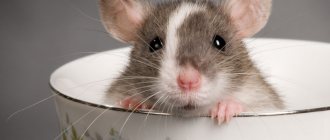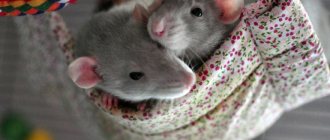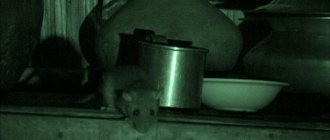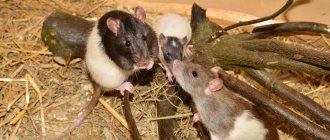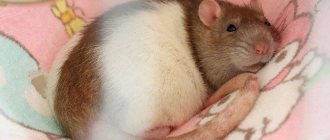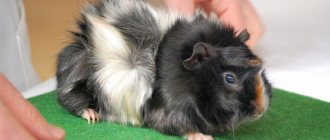| TV Tropes For English speakers and those who want to get to know the topic even more deeply, the TV Tropes project has articles You Dirty Rat!, Swarm of Rats. You can also help our project and transfer valuable information from there to this article. |
| « | If we didn’t fight the rats and let them breed freely, they would take over the entire earth in a year, and we would have to huddle somewhere on cramped Mars. | » |
| — Teacher from O. Grigoriev’s poem “Vitamin of Growth” (1981) | ||
Rat
- The animal is quite smart, quiet and careful. She will not get into trouble, will not attract attention to herself, will hide in the darkness at the first sign of danger, and finally will not try to eat the living main character... Yes, and her length does not exceed 30 centimeters[1]. Overall, it's boring!
So, if the hero climbs into the basement or sewer, he will encounter huge swarms of rats, which, at best, will ignore him and continue to peacefully squeak throughout the entire basement. In the worst case, a wave of half-meter-tall creatures will pour out on the hero from the tunnel, squealing carnivorously, and they will immediately try to dine on the hero. It's not so boring anymore. In general, rats are one of the most common nightmare fuel options.
In addition, they are found in the laboratory as laboratory rats, usually white, and also on ships. The latter are of two types - ship-based and coastal. Sailors don’t like the latter because they chew the wiring. The recipe for dealing with them is simple: you need to get ship rats so that they survive the shore rats. Ship rats are black rats; They have different habits than pasyuks, and they don’t chew high-voltage cables, but they spoil food, which is also bad, but not fatal. Well, if ship rats start scurrying off the ship, that means the ship is doomed. Rarely found in space, because rats are still
have not learned to survive in airless space and are used mainly as a detector of radiation and air quality, sitting quietly and peacefully in cages.
In addition, rats are also found in action films as kamikazes - they are hung with a bunch of explosives and sent through the air ducts to a place where they are smeared with peanut butter. There's usually some bastard sitting there who needs to be blown up.
And finally, the collective mind of rats “Many-as-One” is found in Planescape: Torment. There are also wererats there.
Description of rats
Rats are the most common family mammal. They can be found throughout our vast planet. Despite belonging to the same family, rats differ from mice not only in appearance, but also in behavior.
Additionally, rats are much larger in size than mice. Their body is more developed, the snout is more elongated, the nose is more elongated. The rat's eyes are relatively small, like beads.
When threatened, these rodents begin to secrete a strong-smelling secretion that makes the rest of the family aware of the danger. Despite their size, their body structure is such that they can fit through small openings that make up about 25 percent of their entire body circumference.
Difference between rats and mice
Rats and mice belong to the same suborder, but are very different in appearance and behavior.
The body of mice is small, up to 20 cm, weighing up to 50 grams, rats are twice as large, compact and muscular, weighing up to 900 grams.
The characteristic shapes of the head and eyes are different, in mice it is triangular and slightly flattened with large eyes, in rats the muzzle is elongated with small eyes.
A strong body and strong fingers allow rats to jump up to a height of 1 meter; mice cannot do such tricks.
Mice are cowardly animals and are afraid to get into people's eyes, but rats are not shy, they can defend themselves. There are many cases where they attacked people.
Rats are omnivores, eating meat and plant foods. Mice, on the contrary, prefer grains and seeds.
Appearance
These members of the mouse family have a distinctive rodent-like body structure that is quite robust and oval in shape. Adults grow to 8-30 cm in length and can weigh between 40 and 510 grams. There are species that differ from their counterparts depending on the species as well as the habitat.
The rat's snout is pointed and elongated, with small eyes and ears. The tail of most varieties is completely bare, covered with scales and sparse hair. Black rats are distinguished by the fact that their tail is completely covered with thick black fur.
As a rule, rats have a rather long tail, which is proportional to the length of the body, and sometimes even exceeds it. Although it should be noted that there are also short-tailed rats.
The jaws of this rodent are armed with pairs of incisors, which are noticeably larger than the teeth. The molars are arranged in dense rows so that the rodent can grind food quickly and vigorously. Between the incisors and molars there is an area where teeth do not grow.
Rats do not have fangs, although they are omnivorous mammals. The rat's incisors are constantly growing, which requires constant grinding, otherwise the animal will not be able to completely close its mouth. This is due to the fact that incisors do not have roots.
The front of the incisors is much stronger than the back because it is covered with strong enamel. As a result, the cutters do not grind evenly and end up becoming chiselled.
Their teeth are so strong that rats can easily cope with obstacles such as brick and concrete, although they were originally intended only to obtain plant food.
Interesting information! Rats have fairly thick and dense fur, thanks to their distinct spindly hairs. Coat color can range from gray-brown to dark gray, with varying shades of reddish, orange, or yellow.
Although rats have calluses on their feet, they are poorly developed. Due to the presence of calluses, many animals move quickly over all surfaces. This deficiency in rats is compensated by their persistent and mobile toes.
Therefore, rats can lead both terrestrial and semi-terrestrial lifestyles. They easily move through trees, so they make their nests in tree hollows or use already prepared nests of other animals and birds, left by them for various reasons.
Behavior and lifestyle
Rats are considered incredibly agile living creatures and extremely resilient. For an animal of their size, they run brilliantly, reaching speeds of up to 10 km/h, while overcoming obstacles up to 1 meter high.
These rodents walk an average of 12 kilometers per day. They swim, dive and catch fish easily. Rats can stay in water for up to 3 days, or even longer, without causing harm to their health.
Nurs left by other animals, as well as artificial shelters and nests of various birds, can serve as shelter for rodents. If necessary, the rat can dig a hole for itself.
Rats have no problem living an isolated lifestyle, forming both family groups and territorial communities. A colony may contain several hundred people who are subordinate to one dominant male and several dominant females. Each such group is capable of controlling an area of about 2000 square meters.
Rats have poor eyesight, they are characterized by a small angle of view of about 16 degrees, so the rat constantly turns its head in different directions to explore the space around it. It is believed that rats perceive their surroundings in shades of gray, and darkness appears in red to them.
Interesting fact! Rats have a well-developed sense of smell and hearing, which allows them to hear sounds up to 40 kHz.
Rodents are able to distinguish odors over short distances. However, it should be noted that they can withstand irradiation of about 300 x-rays per hour without any particular difficulty.
How long do rats live?
This indicator is directly related to the species. If we consider gray rats, then under natural conditions their life expectancy does not exceed one and a half years, although some people live up to 3 years.
If we take black rats, they usually live less than a year. Rats kept in laboratories of various scientific institutions live twice as long. The Guinness Book of Records contains information about the oldest rat, which managed to live for almost 8 years.
Sexual dimorphism
When animals are one and a half months old, their sexual characteristics are fully formed. To determine whether it is a female or a male, simply lift the tail to determine the structure of the animal's reproductive system.
Men are different from women:
- By the presence of sufficiently large testicles that can be detected when the animal's tail is lifted.
- Males do not have nipples on their bellies like females. They are located in two rows.
- In males, the distance between the anus and urethra is slightly larger.
- Men are stronger and more powerful and larger in size.
- Males have a pear-shaped body, while females are smooth and elongated.
- Males have denser and tougher fur, while females are smooth, soft and silky.
- Men are less aggressive than women.
- Men's urine is more pungent and has an unpleasant odor.
When it comes to newborn rats, determining their sex is almost impossible. Although experts know that newly hatched males have small spots between their anus and genitals. Over time, testicles appear in place of these spots.
Important note: According to experts, one adult couple can produce up to 6,000 young in a few years. Rats, having reached sexual maturity, are no less active in reproduction.
In natural conditions
In the wild, gray rodents choose places near bodies of water. They like areas with soft soil, in which they can easily dig a hole up to 5 m long. If liquid from a reservoir floods a rat hole, the animal moves to the nearest hollow or builds a temporary nest in a tree. Under natural conditions, an adult individual attacks any creature that is smaller in size.
Rodents usually live in large colonies, attacking anyone who invades their territory. The separation into “friends” and “strangers” occurs due to smell, since all members of the rat colony maintain close contact with each other.
Fighting rats is quite difficult. All traps, mousetraps and other tricks invented by man are not always effective. If one of the individuals dies in a trap, then it informs the entire group of animals about the danger and next time no one will fall for this trick. The same thing happens with poison: rats remember the bait that killed one of their relatives, and will avoid it. Rats cause harm not only by eating and spoiling other people's food supplies. These animals also chew various building materials, electrical cables, etc.
The teeth of these mammals grow throughout their lives, and in order to avoid pressing the bone processes into the jaws, these animals gnaw everything in their path. Rats are capable of destroying even materials with low hardness, such as copper, lead, tin and alloys based on them. According to preliminary estimates, there are almost 2 times more rats living on the planet than people.
Types of rats
Acacia
The acacia rat grows to 10-18 cm in length and weighs 63-150 grams. It has tall fur with a gray-brown tint. The sides of the rodent are painted gray. The belly and lower parts of the body are white. This wild rat species is widespread on the African continent. Its range extends from Kenya to Angola.
This species is nocturnal and nests on branches, in hollows and between the roots of acacia trees. Wild rodents can do without water; they only need liquid food. They feed on fruits, seeds, herbs and even tree resin that drips from the trunks.
Toothless
This wild rat species was first discovered in Indonesia in a tropical mountain forest on the island of Sulawesi. Its appearance is reminiscent of its gray counterparts. But unlike them, he has large ears and an elongated snout. This species of wild rodent has virtually no teeth, with the exception of a pair of large upper incisors.
This is what these unusual animals use when they eat their food. Wild rodents use their incisors like a knife. They first suck up earthworms, cut them into small pieces, and then spit them out and swallow them whole.
Interesting! Scientists have given this wild species the unpronounceable name Paucidentomys vermidax, which translates to “toothless rat.”
Redheads
Representatives of this species are widespread in the territory of the former Soviet Union. They live in homes and farm buildings, which is why they are often called barn dwellers. Their activity does not depend on the time of day, and the ability to reproduce, under favorable conditions, remains throughout the year.
Wild red rats grow up to 25 cm in length and have thick fur that varies in color from bright red to brownish ocher. This species is easily recognized by its wide face, blunt nose and round black eyes.
They have short ears, short legs with prehensilely divided toes, and a grayish-pink tail. Wild red rats' hind legs are much longer than their front legs, and their toes have small webbed feet.
Palm
It is a typical forest species and is not found outside the Nicobar Islands. It inhabits tropical and subtropical mangrove forests. Externally, the palm rat is very similar to a giant mouse.
Bamboo
The bamboo rat is found in southern China, Cambodia, Thailand, northwestern Vietnam, Bhutan and northeastern India. It is installed in self-healing tunnels over 50 m long. That is why it is also called the “mole rat”. This rodent is distinguished by its medium and large size. The length of its body varies between 16.2-45.7 cm, and weight - 210-340 g.
The Chinese bamboo rat is similar to the American poker rat, with short legs and small eyes and ears. It has short, thick fur on its head and body, and sparse hair on its tail. The bamboo rat comes in a variety of colors.
Its color ranges from reddish brown and brown to ash gray and grey. The lower parts of the wild rodent's body are covered with lighter, thinner fur. Some varieties have a white stripe on the crown and from the chin to the throat, so they can be called black and white.
Saccular
This breed of rat lives in Kenya, Uganda, Tanzania and throughout the southern part of the African continent. They are found in light forests, open woodlands, shrub and grassy thickets, agricultural fields and swamps. Wild saber-toothed rodents are nocturnal. They are quite slow and live in solitary burrows with one entrance.
Outwardly, they do not look like other types of rats, but are more similar to marmots or gerbils. Wild rodents have very long hind legs and rely on them only for rapid movement. The tail of baggy rodents is usually longer than the body and is often decorated with tassels.
Most varieties have small, rounded ears, fluffy, soft fur, and large eyes adapted for twilight and night vision. The color of a wild bag rat can vary and depends on the color of the substrate on which it lives.
Interesting. Thanks to their strong, long hind legs, baggy rats can jump up to 2 meters. This species is not afraid of snakes and communicates using a combination of tapping sounds.
There are more than 60 species of wild rats in the world, each of which is unique and interesting in its own way. Fast, mobile and curious, these rodents are nocturnal and live both in the wild and near people.
Kangaroo rats
Length: up to 61 cm. Weight: up to 3 kg.
Infrared marsupial rodents are found only on the Australian continent. These unique animals move in small steps, making their forelimbs less developed than their hind limbs.
Adults grow up to 61 cm in length, and the tail reaches 25 cm in length. The weight of these individuals varies from 1 to 3 kilograms. The largest among this species is the red kangaroo, reaching a weight of 4 kilograms. There is also the rat Paturu. Weighing 3 kilograms, it reaches a body length of 60 centimeters.
They used to inhabit almost the entire continent, but now their numbers have decreased. Introduced foxes and dogs catch large rats, causing the animal population to suffer greatly.
Gambian hamster rat
Length: up to 90 cm. Weight: up to 1.5 kg.
This large rodent of the Independent family, including its tail, is almost 90 centimeters in length and weighs on average between 1 and 1.5 kilograms.
These giants are located south of the Sahara. They came to the United States thanks to a man. They were brought to Florida as pets, escaped and settled into their new home.
They are nocturnal, hiding in dense forests and thickets. They can be trained, and people have taught them to detect ammunition and mines. They can recognize people with tuberculosis.
Curly rat
Otherwise this breed is called Rex. The animal has medium or long wavy hair. The size of an adult rodent is 8-20 cm, tail length is 10-12 cm, weight varies from 350 to 600 g depending on gender. The muzzle is wide and blunt. Skin color can be any color. Life expectancy 3 years.
Tailless rat
The rodent breed was bred in 1983. Rats are born completely tailless, so they have a rounded lump and a stocky body, 22-28 cm long and weighing 250-400 grams. The animal may have a completely different coat color. Average service life is 3-3.5 years.
Turkestan rat
Length: up to 25 cm. Weight: up to 400 g.
The habitat extends from Kazakhstan to the mountainous regions of Nepal. They are used to living at an altitude of more than 1000 meters. The largest colonies are located at an altitude of 4500 meters above sea level.
They live only in the rocky terrain of mountainous regions. They often settle near human farms and residential buildings. In appearance and coloring, they are not much different from their gray counterparts.
In Central Asia, rat colonies are a real disaster for crops and gardens. They grow up to 25 centimeters in length and weigh less than 400 grams.
Black rat
A more aggressive type of rodent, which is most often found in cities. Black rats are smaller than gray ones. Adults have a body length of 55-22 cm and a weight of 132-300 g. The tail is densely covered with hairs and is usually 25-30% longer than the body, but does not exceed 30 cm.
The coat is black and brown in color, while the belly is usually white or yellow. The service life of a rodent is 2-2.5 years.
Bamboo rat
Length: up to 47 cm. Weight: up to 340 g.
The rodent, which learned to live ideally underground, dug for itself in labyrinths. They grow up to 47 centimeters in length, and adults can weigh up to 340 grams.
These animals have thick, soft fur, usually a warm brown color. They are most common in Southeast Asia and the Pacific Islands.
There are three subspecies in the family, which differ in size and coat color. They all eat plant foods. They are excellent excavators, digging a complex system of passages and “storehouses” underground.
Small rat
This is one of the three most common subspecies of rats in the world. They are found in Indonesia, New Zealand, Southeast Asia and Oceania. The wandering rat has the most modest body size among its relatives.
An adult rat weighs 40-80 g, its body length is 11.5-15 cm. The tail is usually as long as the body, and the fur color is brown. Average service life is 2-3 years.
Rat "Standard"
The most common type of domestic rat, which over time man has managed to tame and make his pets. The animals have a massive body that can reach 24 cm in length, weight ranges from 300 to 500 g, and largely depends on the sex and diet of the animal.
The length of the tail can exceed the length of the body by 30-40%. Most often the fur is dark brown or grayish. The lifespan of these rodents does not exceed 3 years.
Rat "Sphinx"
This is a species of decorative rats that are completely hairless. Their body size does not exceed 25 cm, and the tail length is 22-27 cm. They have large ears and almost no mustache. They are friendly creatures with delicate health that require a lot of care and a warm place to live. The lifespan of rodents is 2.5-3 years.
Natural habitats
Rats can safely be called animals that appeared on earth even before people appeared on it. They can be found in almost every corner of our Earth. Depending on the species, they can be found on the Euro-Asian continent, as well as on other continents, including Australia, the Malay Archipelago, New Guinea, etc.
However, their habitat is limited to northern, cold regions. Within the borders of the central belt of Russia, no more than 2 species of rats live - gray and black. If necessary, a rat can travel up to fifty kilometers in one day.
Rats are mammals that easily adapt to fairly harsh living conditions, which is why they can often be found at abandoned research stations in Antarctica.
Danger to humans
The confrontation between humans and rats has been going on for thousands of years. In our time, such a struggle has received an official name - rodent control. Despite its notoriety in Europe and many other countries, including America, in some eastern countries this rodent has received the status of a divine animal, symbolizing wealth, wisdom, prosperity, etc. The negative image of this rodent is associated with several plague epidemics in Europe, which are carried by rats.
Important note: Rats cause serious economic damage, which is associated with spoilage and consumption of all kinds of goods, both food and non-food. These rodents damage the insulation of electrical circuits, leading to fires that kill many people, not to mention causing property damage.
Some types of rats cause serious damage to the crop, as they simply destroy it. Therefore, in such conditions, people resort to various methods of protecting crops from rodent infestation.
In some cases they are simply repelled, and in some cases they are physically destroyed. Rats now pose a serious threat to the health of all humanity, since these rodents are carriers of pathogens of dangerous diseases. They are also dangerous because they can enter people's homes undetected through sewers and ventilation systems.
Despite the constant and serious fight against rats and other rodents, it has not yet been possible to completely eliminate them, but the population of these pests can be controlled.
Experts have established certain standards for deratization, providing for an optimally acceptable percentage of the territory free from rodents.
Here's why it's important:
- 80% is a satisfactory result.
- 90% is a good result.
- 95% is an excellent score.
Therefore, it is assumed that the work of special pest control services is to maintain an acceptable percentage of rodents in a particular area that would not cause serious damage to human livelihoods.
Organizations carrying out pest control
Since rats are a scourge throughout the country, the issue of their destruction is decided at the state level. There is even a law of the Russian Federation obliging the heads of administrations of all settlements and all legal entities to engage in pest control in the territory under their jurisdiction. This does not mean that they themselves must destroy all the rats - their task is to ensure the result by hiring professionals in the field of pest control. The direct performers of this work at the moment are exclusively private companies that provide disinsection, disinfection and deratization services to both individuals and legal entities. In socialist Russia, this function was performed by state sanitary and epidemiological stations, but now they are entrusted only with the tasks of supervision, control and scientific research. Entrusting the direct extermination of rats to private companies was a strategically correct decision - in a competitive environment, each performer strives for quality and gives a guarantee for his work. In addition, small companies are able to quickly resolve all issues without bureaucracy and additional approvals. They themselves purchase drugs, equipment and personal protective equipment, ensure the timely replenishment of all resources for successful and uninterrupted work, which clumsy government structures financed by the state budget cannot boast of. The best companies are always those that have entered this market a long time ago and intend to work in this area seriously and for a long time. They have many years of experience, knowledge and a whole arsenal of necessary means for exterminating rats. A striking example of such a successful company is the SES-24 company.
Population and species status
Since the beginning of the third millennium, the black rat population has declined significantly and become fragmented. According to experts, black rats have begun to be replaced by more fertile gray rats (pasuks). However, despite high fertility, rat populations do not cross the “red line”, since their numbers are controlled by a number of important factors.
Firstly, the abundance of these animals directly depends on the availability of food and places for shelter. Food shortages immediately lead to population decline. In addition, there are special rat control services.
The number of these animals is constantly declining due to some diseases, as well as due to hunting by many predators. Therefore, despite their high fertility, which leads to a constant increase in their number, natural factors, as well as rat control services, do their job.
Currently, most rat species are not even found near the danger zone, although there are very rare species that are protected. As a rule, the abundance of rare species largely depends on the actions of humans, who develop more and more land associated with the natural habitat of these species.
Franklin Island is home to a very rare species of domestic rat. Due to its limited habitat, the species is classified as endangered. Currently, only about 2,000 people live in the area. Annual deforestation and forest fires can reduce the kangaroo rat population.
Features of feeding a rodent
The domestic decorative rat is an omnivore, but this does not mean that you can feed it just anything. Her health depends on the quality of her diet. The basis of the diet is cereals. You can offer buckwheat, rice, corn, barley or wheat raw or after cooking, but without salt.
The rodent will happily eat flax seeds, pumpkin seeds or nuts. Vegetables and greens are sources of vitamins. The domestic ornamental rat loves broccoli, carrots, cucumbers, zucchini and eggplant. In summer you can treat her with dandelion leaves, plantain leaves, and a small amount of parsley.
Meat is a source of animal protein. You can give your pet a chicken egg, boiled boneless fish, poultry fillet, as well as offal - hearts or stomachs.
Fermented milk products help improve digestion and strengthen the rodent's immunity. The domestic decorative rat loves kefir, classic yogurt and low-fat cottage cheese. Sometimes you can pamper your rodent with a piece of apple, grape or watermelon.
A decorative pet rat should not be fed:
- sweets - candies, chocolate;
- spicy, salty or fried foods;
- potatoes;
- fresh cabbage;
- spinach;
- tomatoes;
- onions;
- garlic;
- unripe bananas;
- fatty foods.
Important! The rodent should not be overfed. A fat rat is susceptible to diseases of the cardiovascular and endocrine systems.
Interesting facts about rats
Rodents evolved long before humans. And they have existed for many centuries.
This allowed us to study their characteristics in detail and learn interesting facts about rats:
- The animals are extremely intelligent and intelligent and can be trained just as well as dogs;
- Mammals are susceptible to stress and mental disorders that can lead to death;
- Rodents, like people, have dreams;
- Some people are ticklish and may laugh when tickled;
- Animals sense approaching danger, so they leave the “bad” place en masse;
- If necessary, animals jump to a height of up to 2 meters;
- Rodents can go without water longer than camels.
Residents of Laos, Cambodia, parts of Thailand, Indonesia and China still eat rats, considering their meat an exquisite delicacy.
Reproduction and offspring
Rats, regardless of species, reproduce very quickly. This is also due to the fact that they reach sexual maturity quickly. Women give birth at short intervals. A mature woman can mate every 5 days, except during pregnancy.
Over the course of 1 year, each adult female gives birth to up to 4 dozen rats, whose gestation period is about 3 weeks. Upon reaching one and a half years, women approach menopause, which at first occurs irregularly, and then the female is no longer capable of reproduction.
Until the end of the pregnancy period, the female is busy cleaning the nest. She places soft grass at the bottom of the nest. Sometimes the female digs a new hole and then makes a new nest. Often the female keeps a supply of food in this nest, so she can stay with the newborn for a long time without any problems.
Depending on the species, female rodents can give birth to 8 to 15 offspring at a time. Rats are born naked, blind and deaf, with completely closed ear canals and without a well-developed thermoregulatory system.
After birth, they cannot excrete processed ingredients on their own. Therefore, the female constantly licks her belly, as if massaging it, which helps to activate metabolic processes.
The young are fed with mother's milk, which contains up to 9 percent fat. Unfortunately, rats are capable of destroying their offspring, and males are more likely to do this. As for females, they can eat dead young or very weak ones.
Interesting information! House rats can mate with black rats, but their offspring do not survive and often the mother's body rejects the embryos completely and nonviable offspring are born.
After some time, the rats develop fur, and within a week they can see and hear. On the ninth day, the first incisors of the young begin to appear. After 3 weeks, the young generation independently explores the surrounding area, and after another week they are ready for independent living. They become fully adult at the age of one year.
Capable of mutual assistance
There is an opinion that in nature, everyone is for himself, the fittest survives, etc. All this is a big simplification. And rats are proof of this.
Neuroscientist Peggy Mason of the University of Chicago was surprised to discover that rats will help each other if one of them is in trouble. The basis of his conclusions is unclear, but he concluded: rats have empathy for each other.
Other scientists have also become convinced that mutual aid is practiced in a rat society. They report: rats have nurseries for babies and a kind of “nursing home” - providing food for old blind animals. It was even noted that in case of danger, old rats are escorted to a secluded place.
However, with all this, rats can devour a sick relative without a twinge of conscience. Yes, rats are cannibals. The villainous mother also does not hesitate to eat her weak and sick children. But she is caring towards others and keeps the nest clean.
Rat.
visualhunt.com
Rat.
visualhunt.com
Rat.
visualhunt.com
